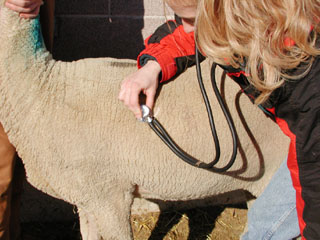Pneumonia, sometimes
called goat shipping fever, is one of the
most common problems encountered in sheep and goats today. Lambs and kids are
particularly susceptible to pneumonia. It is a significant cause of decreased
productivity and increased treatment costs. Early diagnosis and proper treatment
are critical in controlling this problem.
Causative Agents: Most cases of pneumonia are caused by bacterial, viral,
and parasitic infections. Pasteurella haemolytica and Pasteurella
multocida are bacterial organisms carried in the respiratory tract of many
normal animals. Most newborns are exposed to these organisms, but do not develop
the disease because of natural resistance, a healthy environment, and ingestion
of antibodies in colostrum that help control the infection. Viral agents such as
parainfluenza-3 (PI3) are common in sheep and goats and can increase
susceptibility to infection by causing inflammation of the respiratory tract.
Certain infections of ovine progressive pneumonia (OPP) and caprine arthritis
encephalitis (CAE) can cause pneumonia in sheep and goats. Other organisms,
including Mycoplasma, Dictyocaulus (lung worms), and Eimeria
can also cause lung problems.
In many cases, high humidity, dust, damp bedding, excessive heat, tight
buildings with inadequate ventilation, and irritating gases such as ammonia
compromise disease resistance and natural defense mechanisms in the sheep or
goat, allowing pneumonia to develop. Weakness from a difficult birth, inadequate
intake of colostrum, and other stresses contribute to the development of
pneumonia in nursing animals. Often, a mild viral infection will occur,
compromising the animal and allowing secondary bacterial infections to take
place.
Clinical Signs: Young nursing animals that develop pneumonia commonly
lose weight, become gaunt and lethargic, fail to nurse, and usually have a
moderate fever. If the pneumonia remains undetected, serious lung damage will
result and treatment will not be effective. Additional clinical signs include
the following:
- Clear to yellow, runny to thick nasal discharge.
- Coughing and/or rapid breathing.
- Harsh lung sounds heard when listening with a stethoscope.
- Fever (temp. >103.5°).
Young animals that recover are susceptible to relapse during the feeding
period and are more likely to suffer from heat stress and chronic cough.
Coughing can lead to serious problems with rectal prolapse in feeder lambs.
BUY THIS MANUAL NOW and have access to this article and 100's of others
just like it!
Disease Transmission: Most of these infectious organisms are spread by
direct contact with body fluids (saliva, nasal discharge, etc.) and fecal
material. These problems can also be transmitted from one animal to another by
contaminated hands, buckets, feeders, troughs, and equipment.
Diagnosis: Because lethargy and fever in sheep and goats may have several
causes, a careful physical examination is required. In many cases, an exact
(definitive) diagnosis is made by post-mortem (necropsy) examination. This list
contains some key areas to help determine a diagnosis:
- The initial diagnosis can be made from general appearance and physical
exam. The information on page C888 show regions of the lungs that should be
listened to when using a stethoscope.
- Culture and sensitivity performed on nasal secretions or on samples taken
at necropsy can help identify the specific cause of the infection.
- To accurately identify an infectious cause of pneumonia, a transtracheal
wash performed by a veterinarian, with culture and sensitivity, may be
necessary.
Treatment: Treatment must be based on early identification of affected
individuals and depends on whether the cause is bacterial, viral, or parasitic.
Fluid therapy, if practical, often helps the recovery rate. Producers should be
sure that sick newborns are nursing or that they are provided supplemental milk
via stomach tube. In serious outbreaks, it is often advisable to treat all
exposed animals with a therapeutic dose of antibiotics for several days.
- Bacterial Causes -
- Treatment with antibiotics such as penicillin, tetracycline, Albon,
Gallimycin and even LA-200 may be considered. Like most bacterial
infections, culture and sensitivity testing is recommended. See the
antibiotic information in Section H.
- Viral Causes -
- Treatment for all viruses involves treating the symptoms, not
killing the virus. With this in mind, fluids, anti-inflammatory agents (Banamine),
and antibiotics for secondary bacterial infections are recommended.
- Parasitic Causes -
- Most parasites can be treated using ivermectin or doramectin. Routine
de-worming will also help prevent the parasitic causes of pneumonia.
Additional suggestions can be found on page B620.
Prevention and Control: Good management is the key to preventing
respiratory problems. Producers with young animals that have pneumonia often
have ventilation problems in the lambing/kidding and nursing facilities. Most
commonly, the areas lack ventilation, resulting in high humidity and noxious
gasses such as ammonia. In these conditions, the concentration of infectious
organisms also rises. Well-ventilated (but cool) housing is probably ideal.
Newborn animals should be dried off and then provided adequate colostrum intake.
Weaker animals that fail to nurse should be provided colostrum via a stomach
tube. Keep the bedding dry or newborns will chill and develop pneumonia. Do not
skimp on bedding during the early nursing period.
Newborn animals should be provided supplemental heat only until they are dry
and have nursed. Avoid overcrowding and do not keep the birthing areas too warm.
Other than exposure to heavy drafts, healthy animals can tolerate cold fairly
well. If electric fans are used, there should be at least four air changes per
hour.
Parainfluenza-3 virus is a mild but common infection of young animals.
Vaccination of young lambs (in problem flocks) with nasal IBR-PI3 vaccine
at two or three days of age has helped reduce problems in some cases. The IBR
vaccines should not be used in goats; there is a chance that the vaccine
may actually cause this disease!
* If an animal has an infectious cause of pneumonia, it should be isolated
from the rest of the flock/herd. No matter the cause of the pneumonia, caution
should be used to prevent additional spread of the disease by contaminated
clothing, hands, buckets, troughs, etc.
